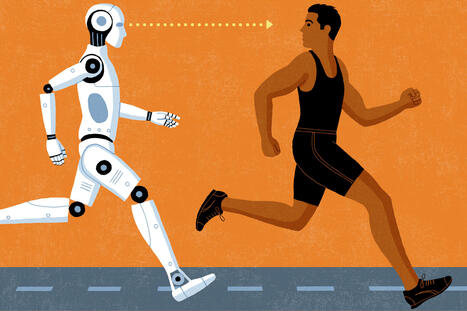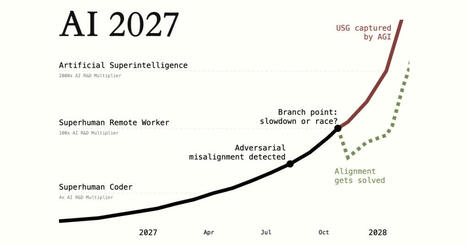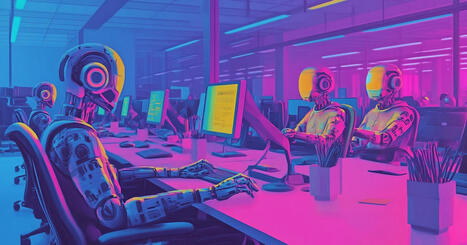 Your new post is loading...

|
Scooped by
Edumorfosis
June 6, 6:37 PM
|
In 2024, the largest U.S. tech companies earned $268 billion from AI advancements, but hundreds of thousands of middle-class jobs were lost. AI is automating white-collar roles in law, finance, journalism, and education, undermining traditional career paths.
This shift reduces job stability, income predictability, and upward mobility for mid-skilled workers. Entry-level positions essential for skill-building are disappearing, limiting professional growth.
Wealth increasingly concentrates among AI company owners, while workers face unstable, low-paying jobs. Between 1979 and 2022, productivity grew 64.6%, but worker pay rose only 17.3%. The middle class’s shrinking share of wealth threatens social and economic stability in the U.S.

|
Scooped by
Edumorfosis
June 5, 12:25 PM
|
Mientras conversábamos sobre inteligencia artificial y su creciente influencia en la economía global, surgió una inquietud que aún retumba en mi mente: ¿por qué este tema no se discute de forma más pública y estratégica, sobre todo en contextos como el nuestro? Si las máquinas están asumiendo más funciones humanas cada día, ¿qué sucederá con el trabajo… y con nosotros?
Esta pregunta nos obliga a mirar hacia una teoría que apenas empieza a consolidarse, pero que podría marcar el rumbo de las próximas décadas: la economía post-trabajo. Lejos de ser una distopía futurista, esta teoría plantea un escenario donde la automatización —desde simples árboles de decisión hasta sistemas autónomos con Inteligencia Artificial general (AGI)— desplaza de forma permanente al trabajo humano como principal motor económico.

|
Scooped by
Edumorfosis
June 1, 10:17 PM
|
Businesses are racing to replace people with AI, and they're not waiting to first find out whether AI is up to the job.
Why it matters: CEOs are gambling that Silicon Valley will improve AI fast enough that they can rush cutbacks today without getting caught shorthanded tomorrow. - While AI tools can often enhance office workers' productivity, in most cases they aren't yet adept, independent or reliable enough to take their places.
- But AI leaders say that's imminent — any year now! — and CEOs are listening.

|
Scooped by
Edumorfosis
June 1, 10:02 PM
|
For more than a decade, I’ve argued that the “knowmad” future, where value is created by context, creativity, adaptability, and collaborative intelligence, isn’t science fiction. It’s our only viable path forward. The tragedy is that our institutions are still obsessed with producing “ready workers,” modeled after industrial- and information-era work, instead of attending to the development of “ready humans,” ready to lead in whatever future is thrown at us.

|
Scooped by
Edumorfosis
June 1, 3:27 PM
|
Recent advances in artificial intelligence have triggered widespread anxiety about the future of work. These concerns aren’t misplaced. Unlike previous technological revolutions, which ultimately increased demand for labor, the current wave of AI development threatens to fundamentally alter the relationship between labor and capital in ways we have not seen before.
I strongly believe in the power of technological progress to improve human well-being. Innovation has been the primary driver of rising living standards throughout history. However, ensuring that these forces improve the human condition requires that technological advances move in the right direction and allow our institutions of governance to keep pace.

|
Scooped by
Edumorfosis
June 1, 11:57 AM
|
Many of those working at the companies building the biggest and most powerful AI models believe that the arrival of AGI is imminent. They subscribe to a theory known as the scaling hypothesis: the idea that even if a few incremental technical advances are required along the way, continuing to train AI models using ever greater amounts of computational power and data will inevitably lead to AGI.

|
Scooped by
Edumorfosis
June 1, 10:24 AM
|
AI 2027 is imaginative, vivid, and detailed. It “is definitely a prediction,” Kokotajlo told me recently, “but it’s in the form of a scenario, which is a particular kind of prediction.” Although it’s based partly on assessments of trends in A.I., it’s written like a sci-fi story (with charts); it throws itself headlong into the flow of events. Often, the specificity of its imagined details suggests their fungibility. Will there actually come a moment, possibly in June of 2027, when software engineers who’ve invented self-improving A.I. “sit at their computer screens, watching performance crawl up, and up, and up”? Will the Chinese government, in response, build a “mega-datacenter” in a “Centralized Development Zone” in Taiwan? These particular details make the scenario more powerful, but might not matter; the bottom line, Kokotajlo said, is that, “more likely than not, there is going to be an intelligence explosion, and a crazy geopolitical conflict over who gets to control the A.I.s.”

|
Scooped by
Edumorfosis
May 22, 11:25 AM
|
- PricewaterhouseCoopers laid off about 1,500 employees this week, citing low turnover and the need to better align with client needs.
- “This was a difficult decision, and we made it with care, thoughtfulness, and a deep awareness of its impact on our people, appreciating that historically low levels of attrition over consecutive years have made it necessary to take this step,” a spokesperson for the Big Four accounting and consulting firm said in a statement sent to CFO Dive.
- The layoffs affected professionals in PwC’s assurance and tax lines of service, including accountants. The spokesperson said the cuts weren’t related to AI adoption or AI investments.

|
Scooped by
Edumorfosis
May 14, 11:15 AM
|
- Existing generative AI technology already has the potential to significantly disrupt a wide range of jobs. We find that more than 30% of all workers could see at least 50% of their occupation’s tasks disrupted by generative AI.
- Unlike previous automation technologies that primarily affected routine, blue collar work, generative AI is likely to disrupt a different array of “cognitive” and “nonroutine” tasks, especially in middle- to higher-paid professions.
- Despite the high stakes for workers, we are not prepared for the potential risks and opportunities that generative AI is poised to bring.
- The report emphasizes the importance of developing strategies to proactively shape AI’s impact on work and workers. This includes fostering worker engagement in AI design and implementation, enhancing worker voice through unions or other means, and developing public policies that ensure workers benefit from AI while mitigating harms such as job loss and inequality.

|
Scooped by
Edumorfosis
May 14, 11:04 AM
|
As the Generative AI race heats up, it’s important to examine where in the U.S. the technology might boost or harm workers, or if place even matters.
Last fall, Brookings published a report looking at possible patterns of AI involvement in the labor market, focusing on how generative AI appears set to intersect with particular occupations, regardless of their location. There, we found that more than 30% of all workers could see at least 50% of their occupational tasks affected by ChatGPT-4, while 85% of workers could see at least 10% of their tasks affected, with greater impacts possible.

|
Scooped by
Edumorfosis
May 10, 7:55 AM
|
Last year, HBR published a piece on how people are using gen AI. Much has happened over the past 12 months. We now have Custom GPTs—AI tailored for narrower sets of requirements. New kids are on the block, such as DeepSeek and Grok, providing more competition and choice. Millions of ears pricked up as Google debuted their podcast generator, NotebookLM. OpenAI launched many new models (now along with the promise to consolidate them all into one unified interface). Chain-of-thought reasoning, whereby AI sacrifices speed for depth and better answers, came into play. Voice commands now enable more and different interactions, for example, to allow us to use gen AI while driving. And costs have substantially reduced with access broadened over the past twelve hectic months. With all of these changes, we’ve decided to do an updated version of the article based on data from the past year. Here’s what the data shows about how people are using gen AI now.

|
Scooped by
Edumorfosis
May 9, 9:38 AM
|
En 2023, uno de cada cinco jóvenes de todo el mundo no tenía empleo ni estudiaba ni recibía capacitación, y las mujeres conformaban las dos terceras partes de este grupo (i). En Estados Unidos, más de la mitad de los universitarios recién graduados tienen trabajos que no requieren un título universitario (i).
La falta de empleos de oficina productivos y estables para quienes tienen diplomas universitarios es especialmente grave en las economías en desarrollo, donde la creación de tales puestos de trabajo es escasa.

|
Scooped by
Edumorfosis
May 7, 10:53 AM
|
Su mensaje fue bastante claro y contundente: la escasez de trabajadores humanos es real y la solución está en la robótica. “Para finales de esta década, faltarán al menos 50 millones de trabajadores en el mundo. Si pudiéramos, pagaríamos 50.000 dólares a cada uno, pero probablemente terminaremos pagando esa cantidad a los robots para que trabajen”, comentó Huang.
|

|
Scooped by
Edumorfosis
June 6, 4:48 PM
|
Este video explora una de las preguntas más urgentes de nuestro tiempo: ¿va la inteligencia artificial a destruir millones de empleos? A partir de una impactante declaración de Dario Amodei, que predice la desaparición del 50% de los trabajos junior de oficina antes de 2030, analizamos cómo otras revoluciones tecnológicas cambiaron el mercado laboral y qué podemos aprender de ellas. Además, planteamos qué se puede hacer: cómo prepararnos, qué formación es necesaria y por qué es urgente empezar a hablar de nuevas soluciones para el futuro del empleo.

|
Scooped by
Edumorfosis
June 2, 9:05 AM
|
When the chief executive of a large tech firm based in San Francisco shares a drink with the bosses of his Fortune 500 clients, he often hears a similar message. “They’re frustrated and disappointed. They say: ‘I don’t know why it’s taking so long. I’ve spent money on this. It’s not happening’”.
For many companies, excitement over the promise of Generative Artificial Intelligence (ai) has given way to vexation over the difficulty of making productive use of the technology. According to S&P Global, a data provider, the share of companies abandoning most of their Generative-AI Pilot Projects has risen to 42%, up from 17% last year. The boss of Klarna, a Swedish buy-now, pay-later provider, recently admitted that he went too far in using the technology to slash customer-service jobs, and is now rehiring humans for the roles.

|
Scooped by
Edumorfosis
June 1, 10:15 PM
|
Dario Amodei — CEO of Anthropic, one of the world's most powerful creators of artificial intelligence — has a blunt, scary warning for the U.S. government and all of us: - AI could wipe out half of all entry-level white-collar jobs — and spike unemployment to 10-20% in the next one to five years, Amodei told us in an interview from his San Francisco office.
- Amodei said AI companies and government need to stop "sugar-coating" what's coming: the possible mass elimination of jobs across technology, finance, law, consulting and other white-collar professions, especially entry-level gigs.

|
Scooped by
Edumorfosis
June 1, 9:50 PM
|
En OPPENHEIMER PRESENTA analizamos el futuro del trabajo y los estudios en medio del auge de la inteligencia artificial. Según un nuevo reporte reseñado por The New York Times, desde 2027 la I.A podría generar cambios súper humanos al nivel de la revolución industrial en el ámbito laboral y académico.

|
Scooped by
Edumorfosis
June 1, 12:33 PM
|
As artificial intelligence (AI) marches forward, a common refrain has emerged: We need to retrain workers, “upskilling” them to better meet the demands of the modern economy. Yet there has been comparatively little discussion about what these programs look like and their feasibility. The evidence that does exist, however, provides reasons for policymakers to be skeptical of retraining as a means of supporting labor adjustment to AI-enabled automation. For retraining to keep up with AI advancements, we may need to fundamentally rethink how we provide it, study its effects, formulate its overarching goals, and understand its limitations.

|
Scooped by
Edumorfosis
June 1, 10:28 AM
|
We predict that the impact of Superhuman AI over the next decade will be enormous, exceeding that of the Industrial Revolution.
We wrote a scenario that represents our best guess about what that might look like. It’s informed by trend extrapolations, wargames, expert feedback, experience at OpenAI, and previous forecasting successes.

|
Scooped by
Edumorfosis
May 24, 2:04 PM
|
Much of the interest on AI and work concerns its possible effects on job losses – will jobs be replaced by AI or will they be transformed? While it is not possible to predict the future – particularly as the technology is still evolving – ILO researchers first developed a methodology in 2023, and later refined it in 2025, to estimate the potential effects of generative AI on existing occupations, and then in a second step, on employment.

|
Scooped by
Edumorfosis
May 20, 9:39 AM
|
Una universidad estadounidense hizo el experimento para medir cuán eficiente es la inteligencia artificial sin supervisión humana. ¿Qué tareas lograron resolver y en cuáles fracasaron? En diálogo con Infobae, los investigadores analizaron los límites en la autonomía de las máquinas

|
Scooped by
Edumorfosis
May 14, 11:09 AM
|
In the face of this unprecedented challenge, copyright law cannot evolve to create a balanced outcome. Generative AI technology is not a means of mass reproduction and distribution of already-created content, rather content companies and the creators who work with or for them will use it to create genuinely new content.
As a result, the deeper and longer-term conflict involving generative AI does not pit technology companies against content owners; it pits the content owners against their own workers and suppliers. The contested terrain in this labor-management dispute lies outside the reach of copyright law. Copyright law has an important role to play in the coming transition, but a balanced solution must come from elsewhere.

|
Scooped by
Edumorfosis
May 10, 7:59 AM
|
Generative AI (GenAI) continues to evolve, with new use cases and applications emerging regularly. A year after my initial research, it’s clear that while technical uses remain prominent, there has been a significant shift toward more personal and emotional applications. In particular, “Therapy / companionship” has emerged as the top use case, with many users turning to AI for emotional support, grief processing, and self-reflection. The non-judgmental, always-available nature of these interactions has made AI an essential tool for mental and emotional well-being.
Alongside this, new use cases like “Organize my life” and “Find purpose” reflect an increasing demand for AI to help with personal growth and goal-setting. These examples highlight how AI is being used not just for productivity but for self-improvement, offering a more holistic role in people’s lives.
While emotional and personal support has risen in importance, professional applications like “Generate code” and “Enhance learning” have also gained traction, underscoring GenAI’s role in transforming work and education. However, some categories, such as “Generate ideas” and “Fun & nonsense,” have seen declines, signaling a shift toward more meaningful and practical uses of AI.
As users become more familiar with the technology, there’s growing awareness of both its potential and its limitations. While AI is empowering users to learn, solve problems, and enhance their work, concerns about dependency and data privacy remain, particularly as AI’s capabilities continue to expand.

|
Scooped by
Edumorfosis
May 10, 7:32 AM
|
Artificial Intelligence does not change anything about the fundamental nature of sustained competitive advantage when its use is pervasive. Once AI’s use is ubiquitous, it will transform economies and lift markets as a whole, but it will not uniquely benefit any single company. Businesses seeking to gain an innovation edge over rivals will need to focus their efforts on cultivating creativity among their employees.

|
Scooped by
Edumorfosis
May 8, 9:58 AM
|
From bank tellers and retail workers to software engineers and doctors, no line of work or type of business is entirely immune to artificial intelligence.
Despite AI’s potential to save employers on labor costs, increase productivity and spur overall economic growth, it can also lead to the disruption or loss of millions of jobs throughout the next several years.
In fact, the World Economic Forum (WEF) estimates that approximately 83 million jobs could be automated worldwide by 2027. The recent WEF study surveyed more than 800 companies, which employ 11.3 million workers across 45 countries, to gauge the fastest-growing and fastest-declining jobs. Meanwhile, Goldman Sachs places the estimated number of job losses even higher at 300 million jobs.
|

 Your new post is loading...
Your new post is loading...
















![[Video] El 50% del empleo será sustituido por IA antes de 2030 | Edumorfosis.Work | Scoop.it](https://img.scoop.it/HVVZD-4odF_fJgGpnK7G0zl72eJkfbmt4t8yenImKBVvK0kTmF0xjctABnaLJIm9)

![[VIDEO] ¿Qué estudiar para NO ser reemplazado por la IA? ¡Mira lo que dice este premio nobel! | Edumorfosis.Work | Scoop.it](https://img.scoop.it/DJ9vnQ2UKy2UanCeYbSCFjl72eJkfbmt4t8yenImKBVvK0kTmF0xjctABnaLJIm9)





![[PDF] How people are really using Generative AI now | Edumorfosis.Work | Scoop.it](https://img.scoop.it/fK_pLyWk9qgeg7Hqy0p4Bjl72eJkfbmt4t8yenImKBVvK0kTmF0xjctABnaLJIm9)






